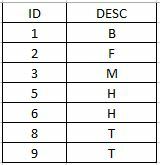I have 100 tables.
In each table, there will be 9 row of records stored with unique ID like { 1,2,3,4,5,6,7,8,9 }
Need to log if there is any missing row in those tables with Unique ID.
For eg:
Below the table, there is missing row 4 and 7. need to find 4 and 7 row.

Please advise how to achieve this task.
Thanks in advance
Venu
Best answer by takashi
View original






